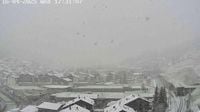Severe weather conditions have gripped the Swiss Alps, particularly affecting the Wallis region, where heavy snowfall has isolated popular tourist destinations and caused significant disruptions to travel and power supply. As of April 17, 2025, the situation remains precarious, with the highest danger level (5) still in effect in the Oberwallis, prompting authorities to issue warnings to residents and travelers alike.
According to meteorologist Roger Perret, the region has experienced an unprecedented accumulation of snow, with reports of between two and three meters falling in a very short period. This extreme weather has rendered areas like Zermatt and Oberems completely cut off from the outside world, as access routes become impassable due to the sheer volume of snow.
"I have been coming to Zermatt for 30 years and have never experienced such weather in April," remarked an English tourist who, along with his family, found themselves stranded in Visp, unable to reach their intended destination. The family expressed their frustration, stating, "If it takes longer, we might just turn back home." They are not alone in their plight, as many travelers have faced similar challenges, with 15 vehicles trapped at the tunnel portal of the Great St. Bernard due to its closure.
In addition to the snow, heavy rainfall in northern Italy has led to road closures and significant concerns about potential storm surges, floods, and landslides. The Simplon line, a crucial train connection between Italy and Switzerland, has been shut down because of flooded tracks, further complicating travel plans for many.
As the weather worsened, the Matterhorn Gotthard Bahn announced on April 17 that there was no travel possible to or from Zermatt, effectively cutting off the area from rail transport entirely. The Swiss Federal Railways (SBB) advised passengers traveling from Basel to Milan to take a detour via Zurich, as the route through Domodossola was also impacted by the weather conditions.
Power outages have compounded the difficulties faced by residents and tourists in the region. Reports indicate that Zermatt and several other communities, including Kandersteg and Adelboden, have been left in darkness due to the adverse weather. Tourists in Zermatt found themselves locked out of their hotels when power outages disabled electronic key systems, forcing them to wait at the train station for updates on their situation.
In response to the ongoing crisis, local authorities have declared a special situation in the Wallis region. Schools of all levels have been closed, and residents have been advised to stay indoors. The exceptional snowfall has raised concerns regarding avalanches and falling trees, with the Alertswiss service warning that such hazards could occur at any altitude.
Meanwhile, supermarkets in Saas-Fee have closed their doors to ensure that food does not spoil due to power failures affecting refrigeration systems. The local government has urged the public to remain vigilant and to avoid unnecessary travel until conditions improve.
Despite the chaos, some residents and visitors have taken the opportunity to reflect on the natural beauty and challenges of living in such a snow-laden region. A local commented, "This is nature, and society must adapt to it. The problems faced in places like Saas Fee and Zermatt are well-known and often stem from excessive tourism during peak seasons."
As of April 18, the weather conditions have begun to stabilize, although significant disruptions remain in place. The waiting rooms at the Simplon car transport in Brig were reported to be overloaded as travelers sought to escape the snowbound region. The authorities continue to monitor the situation closely, with plans to reassess the accessibility of Zermatt on Saturday, April 19.
The Grande Dixence hydropower complex, which produces around 2 billion kWh annually and supplies electricity to approximately 500,000 households, is also facing challenges due to the extreme weather. The facility plays a critical role in Switzerland's energy storage, contributing 20% to the national grid, but the heavy snowfall may impact its operations.
In Italy, areas typically bustling with tourists during the Easter holidays, such as South Tyrol and the Lombardy region, are also grappling with severe weather. The town of Pinerolo, located about 60 kilometers from Turin, has advised residents to remain indoors as authorities deal with the threat of flooding from rising rivers.
While the snow is part of the natural cycle for the Alps, the recent weather events highlight the need for preparedness and resilience in the face of climate variability. As the region works to recover from the current crisis, many are left wondering how future weather patterns will affect both tourism and daily life in these iconic mountain communities.
For now, residents and visitors alike are encouraged to heed the warnings from local authorities, stay safe, and remain patient as the snow begins to melt and the roads reopen.






